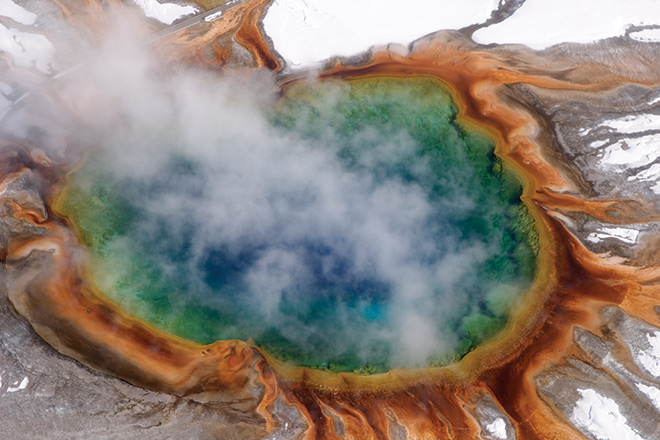5 unusual national park noises that enhance our understanding of the natural world
Soundscapes, like landscapes, are unique. They ground us in a place, providing clues as to where we are and what we can expect. Sounds, like sights and smells, add to our understanding, appreciation, and experience of a place.
What we hear at national parks is such a pivotal element of the visitor experience that the National Park Service actively works to manage the acoustic resources of its parks. Increasingly, these resources are threatened by noise pollution associated with activities both inside and outside park boundaries (e.g., noise from snowmobiles, all-terrain vehicles, airplanes, helicopters, and motorboats, as well as industrial noise such as mechanical drilling from oil and gas wells). Even something as innocuous as an air conditioning unit can infringe on the natural soundscape of a park.
The following is a list of some of the noises—both familiar and rare—that help compose the natural soundscapes in many of our national parks, and might amaze you if you pause and listen.
1. Whistling winds
We all know that wind can whisper, causing trees like the aspen, the larch, and the maple to shiver and flutter their leaves. It can also cause limbs and branches to creak and moan, and tall grass to roll and rustle. But have you ever heard the wind whistle through ancient, red-rock canyons as it careens around corners with enough force to rip tents out of the ground? Mournful like the blast of a train whistle, or eerie like a movie wraith’s shriek, your best bet to hear this windy wonder will be in and around the rock formations of parks like Arches, Canyonlands, and Bryce.
2. Gurgling waters
Another familiar, but varied, element of park soundscapes comes from the movement of water. Waves crash, waterfalls roar, and fast-moving streams rush by—but water makes stranger sounds, too. If you’ve ever visited Yellowstone or Lassen Volcanic, you know that water here tends to gurgle and hiss. Normally accompanied by a tell-tale sulfuric stink, hydrothermal features in these parks (such as bubbling mud pots and steaming, rainbow-colored hot springs) issue glugs, burps, and occasionally a hiss as geysers explode in soaring jets of scalding liquid.
3. Talking animals
Visiting national parks means you might rise in the morning to the titters of songbirds, hike beside whistling marmots or scolding squirrels, and camp within earshot of burping frogs, hooting owls, or laughing coyotes. There are screeching red-tailed hawks,* booming prairie chickens, and trumpeting swans. Bison grunt, otters chirp, raccoons chatter, and bears woof. Two of my personal favorites from park trips of my own include the howl of the wolf in Yellowstone and the high-pitched bugling of the bull elk in Rocky Mountain.
*Fun fact: Movies often dub the sound of the red-tailed hawk over a visual of the bald eagle.
4. Singing sands
The next time you’re out hiking a dune, you might find yourself with a front-row seat to a once-in-a-lifetime concert.
If conditions are right, you may hear a sound akin to pulling a bow across a cello’s strings. Some have even compared this acoustic phenomenon to whale song. It’s true. With the right mix of heat, humidity, and sand conditions, the air around some sand dunes (about 30 worldwide) reverberates with an eerie bass note that might just send little tingles all the way down your spine. Scientists are only beginning to understand how and why, but suffice it to say the dunes have voices of their own.
Want a chance to experience this rare soundscape? Visit Great Sand Dunes or Death Valley National Parks or Mojave National Preserve. To watch a video of scientists manually creating these singing sands in Death Valley, check out this National Geographic clip on YouTube.
5. Silence
Perhaps the most unusual sound of all is the sound of silence. If you’ve ever been parasailing or riding in a hot air balloon, you may remember that moment after reaching a certain height in which the world fell silent. Maybe you felt a little disoriented or like you had cotton stuffed in your ears. Maybe it was even a little jarring. You likely also realized, however, that you were experiencing something precious and rare.
There are few places in our parks that actually achieve this level of quiet. One place is Mammoth Cave National Park. Its unique geology ensures that some stretches of this cave system remain so dry that, unlike in other caves, there is not even the sound of dripping water. As a result, it’s not only an uncommonly dark world, it’s also one of the quietest spots many visitors have ever known.
Visit the National Park Service’s sound gallery to hear more of the cool sounds you might happen upon while visiting national parks. Heard any especially neat sounds on your park travels? Share them below!
About the author
-
 Katherine DeGroff Associate and Online Editor
Katherine DeGroff Associate and Online EditorKatherine is the associate editor of National Parks magazine. Before joining NPCA, Katherine monitored easements at land trusts in Virginia and New Mexico, encouraged bear-aware behavior at Grand Teton National Park, and served as a naturalist for a small environmental education organization in the heart of the Colorado Rockies.




